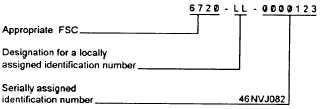NAVY ITEM CONTROL NUMBERS
Items of material not included in the Federal
Catalog System, but stocked or monitored in the Navy
Supply System, are identified by Navy Item Control
Numbers (NICNs). NICNs are 13-character item
identification numbers assigned by Navy inventory
managers for permanent or temporary control of
selected non-NSN items.
LOCAL ITEM CONTROL NUMBERS
Local item control numbers may be assigned to
consumable items that are stocked locally, such as
special developers and camera accessories, that are not
otherwise identified (fig. 5-3). Local item control
numbers consist of 13 characters. The first four
numbers correspond to the FSC of similar NSN items;
the fifth and sixth (NCB code area) are "LL" and the
remaining seven are all numeric numbers.
Item control numbers assigned locally are
authorized for local use only; for example, shipboard
stock records, bin tags, issue documents, and so on.
They are not used in requisitions because these item
control numbers are meaningless to the supply source.
IDENTIFICATION
By now, you can see that the key to getting material
from "supply" is to break the code. Once you have the
NSN for an item, ordering it is easy. There are a number
of methods you can USC to obtain the NSN of an item.
One easy method is to ensure that all your supplies are
identified by their numbers. You should label the bins,
place identification tags on the items, and include the
NSNs on your inventory list. Then, when you start to
run short, you have the NSNs at hand. Most supply
petty officers use this basic method to maintain careful
records of their stock items. There are times when you
need a new item and not a replacement. When a new
Figure 5-3.—Item control numbers assigned locally.
order is required, you must research the item to find the
source.
Your local storekeepers are available to assist you.
They know the system, and this can be of tremendous
help to you. However, they do not know your
equipment and supplies, so you will probably have to
locate the specific item you want in the catalogs.
A word of warning. The supply system is highly
automated. Most foul-ups occur because the
requisition is not completed properly. If you were off
one digit in the stock number or use the wrong NSN,
you may receive an aircraft engine instead of a
typewriter.
In this case, your unit has spent its money
wastefully, and a stock item is withdrawn from the
supply system that may be needed by another ship or
station. You also experience an unnecessary delay
because the material must be reordered.
Even when replenishing supplies, you should check
the current stock numbers. Normally, when a supply
item becomes obsolete, the supply system
automatically tills your order with the current item that
replaced it. However, there are occasions when the
current item is different from the original or uncertainty
exists as to what you really want. Then your requisition
is returned, and you have wasted time.
A number of catalogs and lists are available for you
to use. When ordering replacemcnt supplies or
equipping an activity, you should USC one or more of the
following catalogs: the Management List-Navy, the
Afloat Shopping Guide, the allowance list of your
activity, the DoD Consolidated Federal Supply
Catalog, the Photographic Equipment List, the Navy
Stock List, and the GSA Catalog.
When you are ordering repair parts, the
Manufacturers' Manuals, the Illustrated Parts
Breakdown, and the Consolidated Master
Cross-Reference List (C-MCRL), or (CRL), permit you
to trace the part number provided by the manufacturer
and locate the corresponding NSN.
For ordering publications and keeping the technical
and administrative Ii brary up to date, you should use the
Navy Stock List of Publications and Forms. The
information that follows describes the content of the
various publications and how they can be of use to you.
MANAGEMENT LIST-NAVY
The Management List-Navy (ML-N) is helpful
when you are preparing requisitions. It lists stock items
5-4


